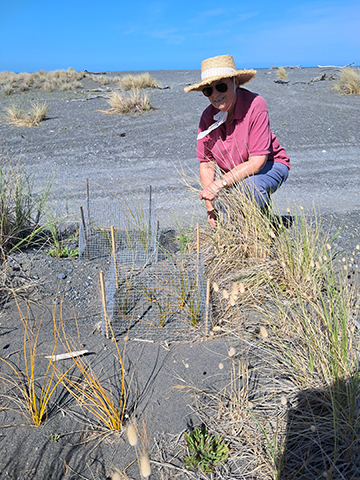Fifty tussock-like plants covered in wire mesh boxes sit in the sand well along the beach-front at Lake Ferry’s Okorewa Lagoon. Few have heard of the unprepossessing native – Pingao – which once ruled the nationwide sand beach landscape until out-competed by English-introduced marram grass.
Now, groups of enthusiasts across the country have begun the long process of recloaking sandy beaches with Pingao, as South Wairarapa Biodiversity Group president Jane Lenting told The Star.
“I got invited to Kuranui marae for a half day (seminar) on pingao. I’d never heard of it … and after talks we went down the coast to look at remnants. There are some remnants there but there’s also a project at Whangaimoana.”
The group looked at the Whangaimoana project – “and that’s when I learnt about (pingao’s) importance and significance,” she said.
Coastal Restoration Trust’s article on the plant (“Pingao _ golden sand sedge”) described it as “once found throughout New Zealand,” but it now only occurs “where there are active replanting programmes.”
Wellington Zoo came to the support of the biodiversity group’s pingao replanting and re-establishment project at Okorewa Lagoon – the beach-front area round the corner from Lake Ferry – through a small grants scheme it runs for community groups.
That was three years ago – and that’s when the group began the process of collecting pingao seed, propagating the tiny plants and starting its journey to recloak the sand areas at the beach.
“There are no dunes at the moment. It’s just flat, but pingao creates dunes. It collects the sand (around the plants), then grows up,gets longer and longer and the dune grows underneath it,”Lenting noted. “So they (pingao plants) bind sand and create sand dunes.”
Pingao recloaking projects currently are under way “all round New Zealand _ in Kawhia, Raglan and so on. I’m going to the Coastal Restoration Trust conference in March in Tolaga Bay – there’s a restoration project up there.
“It’s a big thing around New Zealand – who knew? I didn’t 10 years ago.”
She noted that on the Western Lake side of Wairarapa Moana near the Spit there is a pingao self-propagation programme under way which currently is creating sand dunes – collecting drifting sand as it grows using moisture from deeper in the sand pile.
So far only some 50 pingao plants have been placed into the Okorewa Lagoon’s sandy area, with small wire box cages installed to protect the plants from predators like rabbits – and hopefully from wandering humans.
Cars, 4-wheel vehicles, quads and motor bikes still careen through the area, with the group explaining that putting up protective fences just sees them “pulled out.”
The group has been working at replanting the area round the lagoon in flax, cabbage trees and other natives for just over a decade, with some trips only to clear grass and other regrowth from round the juvenile plants, and replace protective coverings.
“So we got this (pingao) grant from Wellington Zoo and they bought all the propagation materials.” Coastal Restoration Trust had also provided valuable information.
The pingao project began by collecting the “tiny” seed from seed heads, “a time-consuming job,” and the group has learnt that moist propagation conditions attract fungal disease – “there’s no fungus around sand,” – but it occurs in a shade house environment.
“So it’s a little bit tricky” when it comes to propagation, and the earliest it can be planted out “is 18 months – so I’m leaving some of the (current juvenile) plants for an extra year – they will have been two and a half years, so they have been a bit slow” in maturing.
The good news? Of the small group of 50-odd pingao plants “planted out so far, we’ve had no failures. We haven’t had a single plant die, which is pretty unusual for a native plant project.
The group expects to have “a hundred or so” seedlings to transplant into Okorewa Lagoon’s sandy waste next year in late winter.
It sees pingao as a key to recovery along a coastline currently infested by introduced marram grass, lupin and other species.
“It protects coastlines, it protects dunes, it restores dunes back to what it was like before marram was introduced and before there were vehicles on beaches.
“All round the area where we have planted (pingao) there are vehicle tracks, so in terms of expanding planting (vehicles driving through the area) are definitely a problem.
“You have to persuade people … to use a few routes through _ rather than to criss-cross the whole area.”
As for marram grass, it was introduced into virtually every British colonial settlement in Australia, New Zealand, South Africa, the Falkland Islands and Norfolk Island,and has been reported from Argentina and Chile.
As Wikipedia notes: “In essentially all of the locations where they have been introduced, (the) plants are now listed as invasive.”



